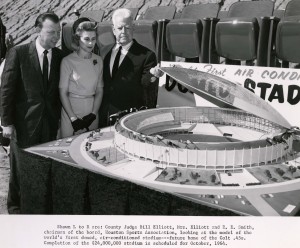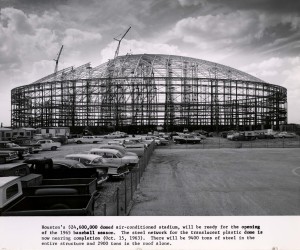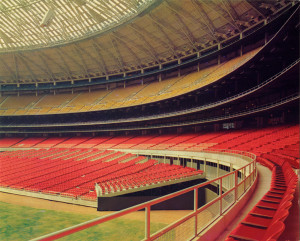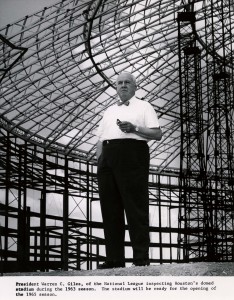
Today the National Trust for Historic Preservation released its 26th annual list of America’s 11 Most Endangered Places, and guess who made the list.
For Astrodome preservationists, the announcement comes not a moment too soon.
Just a few months ago NFL Commissioner Roger Goodell started rattling the wrecking balls, suggesting it would enhance Houston’s chances of hosting the 2017 Super Bowl should the Astrodome be demolished noting, “Whether it’s more parking, whether we can have more events there on that space — it’s not just the stadium itself, it’s the area surrounding it that’s valuable. And, I think that could be a very positive change in their Super Bowl bid.” (Footnote: Houston was later awarded the bid with no definite word on the future of the Dome.)
 So, naturally, the threat of the Dome’s demise has many waxing nostalgic, including yours truly, and finds me digging through the George Kirksey Papers. Kirksey, along with Roy Hofheinz and others, was instrumental in bringing Major League Baseball to Houston. The scope of his papers, held here at the University of Houston Special Collections, extends beyond baseball, but they do contain some real photographic gems from the Dome’s design, groundbreaking, and through its golden era (some included here).
So, naturally, the threat of the Dome’s demise has many waxing nostalgic, including yours truly, and finds me digging through the George Kirksey Papers. Kirksey, along with Roy Hofheinz and others, was instrumental in bringing Major League Baseball to Houston. The scope of his papers, held here at the University of Houston Special Collections, extends beyond baseball, but they do contain some real photographic gems from the Dome’s design, groundbreaking, and through its golden era (some included here).
Goodell was right about the Astrodome and the land it is on being valuable. It is just that not everything can be calculated via a return-on-investment spreadsheet, and the true value of the Astrodome, standing in some form or another, is beyond mere value as we understand it these days in Houston.
Reading the tea leaves of the Dome’s future is an exercise in futility and frustration. However, it is encouraging to see Mayor Parker express interest in preservation ideas akin to the master’s project of UH’s own Ryan Slattery, but the future of the Dome is still in doubt.
 Whatever becomes of it, there is not much that can be said here that has not already been captured by a number of impassioned pleas, linking Houston’s sporting history to that of the Astrodome’s timeline. However, for those who are not sports fans or who did not make memories in this grand experiment of a stadium, let us set aside the history of the Astros, the Oilers, the Houston Livestock Show and Rodeo, the Game of the Century, the Battle of the Sexes, et al. The Astrodome speaks to something larger.
Whatever becomes of it, there is not much that can be said here that has not already been captured by a number of impassioned pleas, linking Houston’s sporting history to that of the Astrodome’s timeline. However, for those who are not sports fans or who did not make memories in this grand experiment of a stadium, let us set aside the history of the Astros, the Oilers, the Houston Livestock Show and Rodeo, the Game of the Century, the Battle of the Sexes, et al. The Astrodome speaks to something larger.
That this audacious figment of our collective imagination (No mosquitoes? Air-conditioned baseball in Houston?!) could be brought into being, transcends the idea or concept of a niche sporting audience and speaks to us not solely in terms of sport. It speaks, perhaps, more in terms of our ingenuity, our desire to always overcome and produce that which seems futile or silly and, admittedly, to do so in ways that may see the execution of it all fall short of our lofty, futuristic visions.
So, there it was built and there it stands, as a monument to all that is comical and wonderful and, yes, endearing about us. It remains a symbol of our moonshot in an era where the Moon seemed suddenly within reach.
Driving by the Astrodome at night, even dwarfed as it is by the sterile Reliant Stadium, it seems to grumble, “We are the masters of our domain. We will control the environment on a massive scale, and we will restore novelty to the novel, creating a spectacle of sport again. We will always figure out how to manifest our yearning in ways that are bigger and infinitely more ingenious, for better or for worse.”
A little hubris, there? Perhaps. But, then, all the more reason to retain it as a reminder. Either as an albatross or our Eiffel, the Dome should stand.

